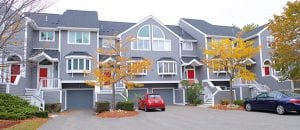
Congratulations! If you live in New England, you’ve probably just endured the most wicked winter in history. Now, it’s time to rejoice in the return of spring, and all the green it brings with the change of season.
While we’re on the subject of green, spring is the ideal time to think about saving money and the planet. As the weather improves, you can make some changes to the home to be more green and more energy efficient. Here are six tips to reduce costs and save energy in your home or apartment. The spring season is the best time to make a change to your lifestyle!

Upgrade to Energy-Efficient Lighting (LEDS)
A simple switch to energy-efficient lighting, such as LEDs, can save your household money in multiple ways. Not only are LEDs longer-lasting than traditional incandescent light bulbs, but they also save homeowners from the constant cycle of replacement buying that can add up over time. Energy.gov states that LEDs “use at least 75% less energy, and last up to 25 times longer.” This makes them a wise choice for reducing energy costs overall. Additionally, LEDs emit less heat, which reduces the strain on cooling systems in the summer, making less of an impact on your HVAC bills.
Whether you are using LEDs indoors or outside, they make a great choice for longevity, cost and the environment.
Digital Solutions for Smarter Energy
If saving money on home energy costs is your ultimate goal, it’s time to automate your home. One way to do this is to install a smart thermostat, allowing homeowners to schedule their heating and cooling usage and adjust temperatures remotely after leaving for work or returning home. Consumer Reports (CR) detailed the savings in a 2023 article, stating that smart thermostats that meet Energy Star criteria save users an average of 8 percent on their utility bills. In the same report, CR states that the other major energy-saving technique is that smart thermostats make it easy to set up a sensible heating and cooling schedule, allowing homeowners to save approximately 10% on those bills.
Upgrade Inefficient Appliances
LEDs and smart thermostats are just two of the small steps homeowners can take to reduce utility bills, upgrading older and inefficient appliances is yet another to consider. Energy-efficient appliances, like ENERGY STAR-rated refrigerators, washing machines, and dishwashers, are built to use less electricity, water, and other resources compared to older, less efficient models. The fewer resources used will be reflected in your monthly water and electric bills.
Operating more energy efficiently is only one benefit of upgrading your older appliances. Newer models are less prone to breakdowns and will require fewer repairs. Even more advantageous is that municipalities and states offer numerous incentives and rebates when buyers invest in energy-efficient appliances.
Inspect and Upgrade Your Windows
Another way homeowners can invest in energy savings is by upgrading drafty windows, which will reduce heat loss in winter and heat gain in summer. If replacement windows are not in the budget, consider thermal drapes that can help seal out drafts during the winter months, or installing a window film that can help reflect heat during the summer months while still allowing visibility.
The Department of Energy estimates that heat gain and loss through inefficient windows are responsible for 25%–30% of residential heating and cooling energy use. Cut those costs through ENERGY STAR-rated replacement windows, thermal curtains or window films that can cut costs across the board.
Conserve on Your Light Usage
Your home’s thermostat isn’t the only place you can save money with automation. Conserving on your light usage can also be possible through motion and occupancy sensors that automatically turn lights on when motion is detected in a room and off again when the room is unoccupied. This is a great option for common areas like entryways, mudrooms, garages, and hallways as they are common locations for lights to be inadvertently left on while not in use. Light sensors, dimmers and timers can make a major impact on your utility and energy usage and ultimately your wallet.
Change Filters
Be sure to routinely change HVAC filters monthly during peak cooling or heating seasons. New filters are typically inexpensive. Dirty filters cost more to use, exhaust the equipment and result in lower indoor air quality.
Whether you live in a home or an apartment, these are changes you can make to be more conservative going into the spring season. If you live in an apartment, consider making these eco-friendly suggestions to your landlord, apartment, or building management. They will most likely abide by your wishes as there’s no reason not to make energy efficient improvements that are cost affordable!


